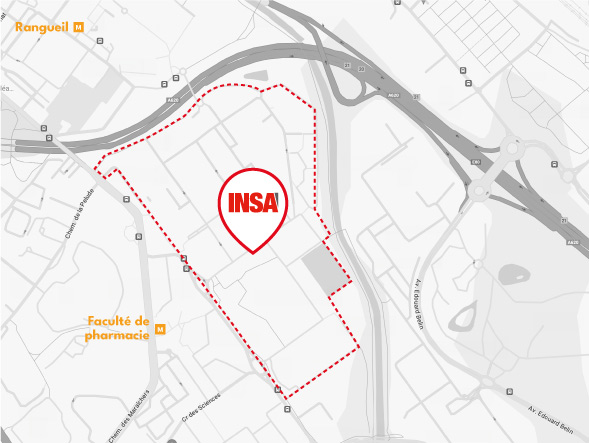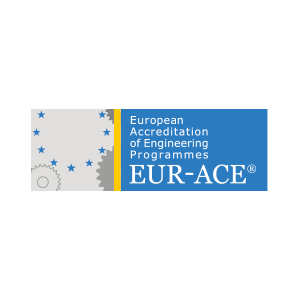Detailed programme for common materials:
6 CMs of 1.25h each
Crystallography of metals and ceramics – Amorphous structures
Thermodynamics of binary metal alloys: Gibbs free energy – Entropy – Enthalpy Binary iron-carbon metal alloy: Phase equilibrium diagram – Eutectoid transformation
Mechanical behaviour of construction materials at room temperature: Elasticity – Plasticity – Ductility – Fragility
Mechanical properties of materials in use and mechanical tests at room temperature
Physical properties of construction materials and associated non-destructive testing
Chemical properties of construction materials and corrosion phenomena
Tutorial topics: 4 tutorials of 1.25 hours each
1/ Crystallography: Pattern – Atomic density – Miller indices
2/ Phase diagram: Iron-carbon diagram – Determination of the microstructure of a steel at room temperature
3/ Mechanical properties: Tensile strength curve and skimming – Strain energy
4/ Chemical properties: Corrosion
Practical work session: 2 TPs of 3 hours each
TP1 Mechanical tests: tensile test – Hardness test – Impact test
TP2 Chemical tests
If the student chooses to approach the objectives with ‘Mechanical Engineering’ oriented materials
– 35.5 hours for a mechanical design project, through the study of a project in a small group, the students approach functional analysis, modelling (schematisation), the search for solutions, pre-dimensioning and the production of a ‘digital mock-up’ using CAD software. Students supplement the knowledge they need to develop the project with various documents at their disposal: resource documents on the ‘moodle’ platform, books, internet.
– 8 hours of practical work on bearing assembly,
– Using the elements made available to them (bearings, gear housing shafts, keys, elastic rings, locknuts, etc.), the students must analyse, design and produce bearing assemblies that comply with current regulations.
– 6 hours on the study and operation of different heat engines. Using visual aids, students discover the different cycles of internal combustion engines, the distribution and supply systems, and the principles of turbojet and turboprop engines. They identify the different functional elements of an engine from an overall drawing.
Materials for Mechanical Engineering – Lesson (7.5h)
– Phase transformations under equilibrium conditions: isothermal (eutectoid and eutectic) and non-isothermal transformations
– Diffusion: Fick’s laws (unidirectional)
– Germination-growth mechanisms of a new phase (from a liquid or a solid phase)
– Mechanical properties of metal alloys: fatigue strength and behaviour in the presence of cracks
TD topics (5h)
1: Use of Fick’s laws in steel carburising
2: Analysis of the microstructural evolution of steels
3: Work hardening – Introduction to residual stresses
4: Conventional fatigue limit and fatigue diagram (Haig)
Practical work (6h)
TP1 Mechanical test: Effect of cold rolling on tensile properties – Alloy Al20217
TP2 Microstructure: Microstructures of steels and white cast irons
If the student chooses to approach the objectives with ‘Civil Engineering’ oriented materials
Civil engineering materials: 18.75 h
– 11.25 h Portfolio lecture on construction materials used in civil engineering
– 2.5 h of tutorials on LCA and quantitative approaches
– 5 h of practical work on materials and numerics
Project design part: 52 h
– 7.5 h Lectures on project principles (architecture and structure)
– 8.75 h Tutorials: architectural analysis, load analysis and structural design in relation to construction techniques
– 2 h site visit
– 33.75 h project work in small groups based on project choices and approach, architectural and structural design, justification of choices, digital modelling, quantification, technical design details, definition and calculations of load transfers and environmental impact study of construction materials.
Objectifs
- Make the link between the mechanical, physical and chemical properties of construction materials (metals, ceramics and polymers) and the characteristics of these materials on an atomic (crystallographic) and microstructural (binary phase diagram) scale.
- Make a reasoned selection of metallic materials for mechanical construction by making the link between the mechanical characteristics and the nature of the metallic alloy: chemical composition, microstructure, nature of the phases, heat treatment possibilities, etc;
- Implement a design procedure based on specifications and acquire a technological culture.
The student may choose to approach this general objective with either a ‘Mechanical Engineering’ or a ‘Civil Engineering’ teaching aid.
If the student chooses to approach the objectives with ‘Mechanical Engineering’ oriented teaching aids, he/she must :
- Propose one or more solutions in the form of a kinematic diagram, based on a set of specifications.
- Calculate the powers involved and choose a motor.
- Design and size a simple gearbox.
- Design and size a radial contact ball bearing assembly.
- Calculate the isostatism of an assembly of fixed parts and a moving mechanism.
- Produce a digital model of the mechanism using CAD software.
- Give an oral and written presentation of the project.
- Participate and get involved in a work group.
- Identify the links to be implemented using real components for the bearings.
- Be familiar with 4-stroke and 2-stroke cycles.
- Be familiar with distribution and supply systems.
- Be familiar with the principles of turbojet and turboprop engines.
- Be able to identify the functional elements of an engine from a drawing.
- Be familiar with the secondary functions (cooling, lubrication, electrical generation, etc.).
- Be familiar with the terminology of the component parts.
If the student chooses to approach the objectives using ‘Civil Engineering’ oriented materials, he or she will be able to :
- Develop an interdisciplinary culture around sustainable urban development,
- To immerse themselves in the complexity of civil engineering design projects and in multi-criteria, multi-actor and multi-scale spatial and temporal decision-making.
- Discover the concepts of eco-design
- Design architectural programmes
- Define, select and specify construction materials
- Justify and assess the environmental impact of the solutions prescribed
- Design the load-bearing structure of buildings (vertical loads only)
- Calculating and predicting load transfer (gravity and operational loads only)
This course is designed to be closely linked to the development of skills in civil engineering project methods, the use of digital tools, the development of design project practices, the discovery of architectural design, the choice of construction techniques and materials and the use and development of multi-criteria and quantitative approaches.
The module provides an introduction to the dual Architect/Engineer curriculum, and develops analytical skills and design methods for building projects within an urban fabric. The project also provides an opportunity to practise the concepts of Resistance of Materials 2 seen in S4, with an understanding of beams, loads and the practical application of the principles of statics.
Pré-requis
For the common core of materials: Notion of Crystallography and Thermodynamics from 1A
If the student chooses to approach the objectives with ‘Mechanical Engineering’ oriented materials
- I2ICTI31 teaching in semester 3 (kinematic diagram, isostatism applied to the assembly of fixed parts, design of an assembly of radial contact ball bearings, knowledge of the rules of industrial drawing, knowing how to use the basic functions of CREO.
- Teaching I2ICME31 in semester 3 (knowing how to use the Fundamental Principle of Statics).
If the student chooses to approach the objectives with ‘Civil Engineering’ oriented materials
- I2ICTI31 teaching in semester 3 GC BIM design with tools linked to the use of a 3D modeller, technical approach to parametric families and objects, collaborative approach.
- I2ICME31 teaching in semester 3 (knowing how to use the Fundamental Principle of Statics).
Évaluation
L’évaluation des acquis d’apprentissage est réalisée en continu tout le long du semestre. En fonction des enseignements, elle peut prendre différentes formes : examen écrit, oral, compte-rendu, rapport écrit, évaluation par les pairs…













